Related Research Articles
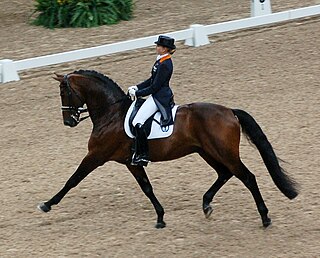
Dressage is a highly skilled form of riding performed in exhibition and competition, as well as an "art" sometimes pursued solely for the sake of mastery. As an equestrian sport defined by the International Equestrian Federation, dressage is described as "the highest expression of horse training" where "horse and rider are expected to perform from memory a series of predetermined movements."

Equestrianism, commonly known as horse riding or horseback riding, includes the disciplines of riding, driving, or vaulting with horses. This broad description includes the use of horses for practical working purposes, transportation, recreational activities, artistic or cultural exercises, and competitive sport.

Horses can use various gaits during locomotion across solid ground, either naturally or as a result of specialized training by humans.

The Tennessee Walking Horse or Tennessee Walker is a breed of gaited horse known for its unique four-beat running-walk and flashy movement. It was originally developed in the southern United States for use on farms and plantations. It is a popular riding horse due to its calm disposition, smooth gaits and sure-footedness. The Tennessee Walking Horse is often seen in the show ring, but is also popular as a pleasure and trail riding horse using both English and Western equipment. Tennessee Walkers are also seen in movies, television shows and other performances.
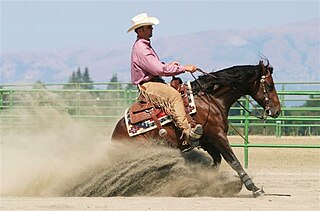
Reining is a western riding competition for horses where the riders guide the horses through a precise pattern of circles, spins, and stops. All work is done at the lope, or the gallop. Originating from working cattle, reining is often described as a Western form of dressage riding, as it requires the horse to be responsive and in tune with its rider, whose aids should not be easily seen, and judges the horse on its ability to perform a set pattern of movements. The horse should be willingly guided or controlled with little or no apparent resistance and dictated to completely. A horse that pins his ears, conveying a threat to his rider, refuses to go forward, runs sideways, bounces his rear, wrings his tail in irritation or displays an overall poor attitude is not being guided willingly, and is judged accordingly.

Equitation is the art or practice of horse riding or horsemanship.

The Missouri Fox Trotter is a horse breed that originated in the state of Missouri in the United States. It was developed in the Ozark Mountains by settlers in the early 19th century, and quickly developed into a gaited breed appreciated for its stock horse abilities, stamina and smooth gaits. It performs an ambling gait known as the "fox trot", a four-beat broken diagonal gait in which the front foot of the diagonal pair lands before the hind, eliminating the moment of suspension and increasing smoothness. The main breed registry was begun in 1948 and as of 2012 registers almost 100,000 horses. A European registry was begun in 1992, and as of 2009 recognizes around 600 Fox Trotters living in Europe. In 2006, a smaller registry, focused on the preservation of the original, historic type, was begun in the United States. The Fox Trotter is a mid-sized, muscular breed, used mainly for trail riding and ranch work.

Western Pleasure is a western style competition at horse shows that evaluates horses on manners and suitability of the horse for a relaxed but collected gait cadence and relatively slow speed of gait, along with calm and responsive disposition. The horse is to appear to be a "pleasure" to ride and very comfortable, while being very smooth. Most light horse breeds in the United States and Canada may compete in western pleasure classes, either in open competition or at shows limited to a single breed. However, horse conformation and temperament play a role in this event, and hence animals that are calm, quiet, have collected, soft gaits and the strong muscling required to sustain slow, controlled movement are the most competitive.
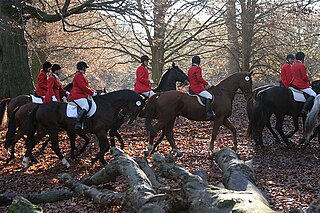
A field hunter, or a fox hunter, is a type of horse used in the hunt field for fox hunting and stag hunting.

The Hunter division is a branch of horse show competition that is judged on the horse's performance, soundness and when indicated, conformation, suitability or manners. A "show hunter" is a horse that competes in this division.

An ambling gait or amble is any of several four-beat intermediate horse gaits, all of which are faster than a walk but usually slower than a canter and always slower than a gallop. Horses that amble are sometimes referred to as "gaited", particularly in the United States. Ambling gaits are smoother for a rider than either the two-beat trot or pace and most can be sustained for relatively long periods, making them particularly desirable for trail riding and other tasks where a rider must spend long periods in the saddle. Historically, horses able to amble were highly desired for riding long distances on poor roads. Once roads improved and carriage travel became popular, their use declined in Europe but continued in popularity in the Americas, particularly in areas where plantation agriculture was practiced and the inspection of fields and crops necessitated long daily rides.
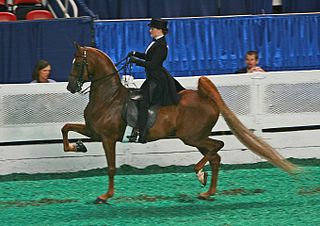
Saddle seat is a style of horse riding within the category of English riding that is designed to show off the high action of certain horse breeds. The style developed into its modern form in the United States, and is also seen in Canada and South Africa. To a much lesser extent, it is ridden with American action horse breeds in Europe and Australia. The horse breeds mainly used for this flashy style are typically the showy Morgan Horse, and the high stepping American Saddlebred.

Equestrianism made its Summer Olympics debut at the 1900 Summer Olympics in Paris, France. It disappeared until 1912, but has appeared at every Summer Olympic Games since. The current Olympic equestrian disciplines are Dressage, Eventing, and Jumping. In each discipline, both individual and team medals are awarded. Women and men compete together on equal terms.

Western riding is considered a style of horse riding which has evolved from the ranching and welfare traditions which were bought to the Americans by the Spanish Conquistadors, as well as both equipment and riding style which evolved to meet the working needs of the cowboy in the American West. At the time, American cowboys had to work long hours in the saddle and often over rough terrain, sometimes having to rope a cattle using a lariat, also known as a lasso. Because of the necessity to control the horse with one hand and use a lariat with the other, western horses were trained to neck rein, that is, to change direction with light pressure of a rein against the horse's neck. Horses were also trained to exercise a certain degree of independence in using their natural instincts to follow the movements of a cow, thus a riding style developed that emphasized a deep, secure seat, and training methods encouraged a horse to be responsive on very light rein contact.

Impulsion is the movement of a horse when it is going forward with controlled power. Related to the concept of collection, impulsion helps a horse effectively use the power in its hindquarters. To achieve impulsion, a horse is not using speed, but muscular control; the horse exhibits a relaxed spinal column, which allows its hindquarters to come well under its body and "engage" so that they can be used in the most effective manner to move the horse forward at any speed.
Competitive trail riding (CTR) is an equestrian sport where riders cover a marked trail for a distance that is usually between 40 miles (64 km) per day. Some rides are only one day long, others may run as long as three days. One-day six-mile events have also become popular. The goal of the competition is to demonstrate partnership between horse and rider. Unlike in endurance riding, factors other than speed are considered. If the ride is timed, it is a form of pace race; otherwise it is a judged trail ride. In a timed ride, horses may not come in under or over a certain time, and veterinary checks, rider behavior and other elements play a role in the placings. The horse is evaluated on performance, manners, and related criteria. "Pulse and respiration" stops check the horse's recovery ability and conditioning.

The show hack is a type of ridden show horse, exhibited to a standard first established in England.

Lead refers to which set of legs, left or right, leads or advances forward to a greater extent when a quadruped animal is cantering, galloping, or leaping. The feet on the leading side touch the ground forward of its partner. On the "left lead", the animal's left legs lead. The choice of lead is of special interest in horse riding.
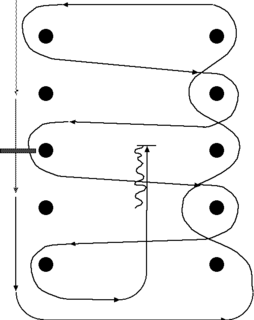
Western Riding is a competitive event at American horse shows, particularly those for stock horse breeds such as the American Quarter Horse. It is not to be confused with the general term "western riding," referring to the many forms of equestrianism where riders use a western saddle; instead, it refers to a particular class where the horse and rider complete a pattern that incorporates elements of both reining and trail classes, but requiring horses to perform in a quiet style akin to that of a Western pleasure class. Horses are evaluated on “quality of gaits, lead changes at the lope, response to the rider, manners and disposition." While all three gaits are required, most of the pattern is performed at a lope. Emphasis is placed on the horse's smoothness, even cadence, and precise, clean flying lead changes.

Western dressage is an equestrian sport that combines the principles of dressage riding and the use of western tack. Riders typically wear western attire, such as button-up shirts, cowboy boots and jeans. All horse breeds are permitted to compete in western dressage.
References
- Strickland, Charlene. Competing in Western Shows & Events. Storey Books, div. Storey Communications, 1998. ISBN 1-58017-031-5
- United States Equestrian Federation 2007 Rule Book Western Division